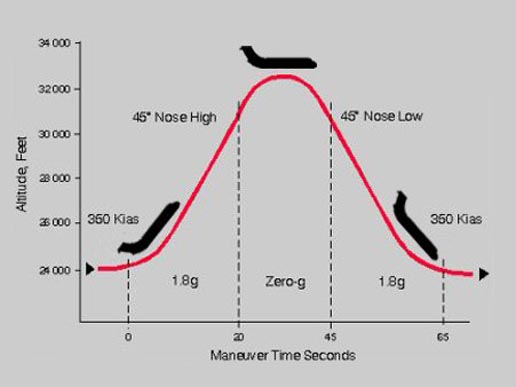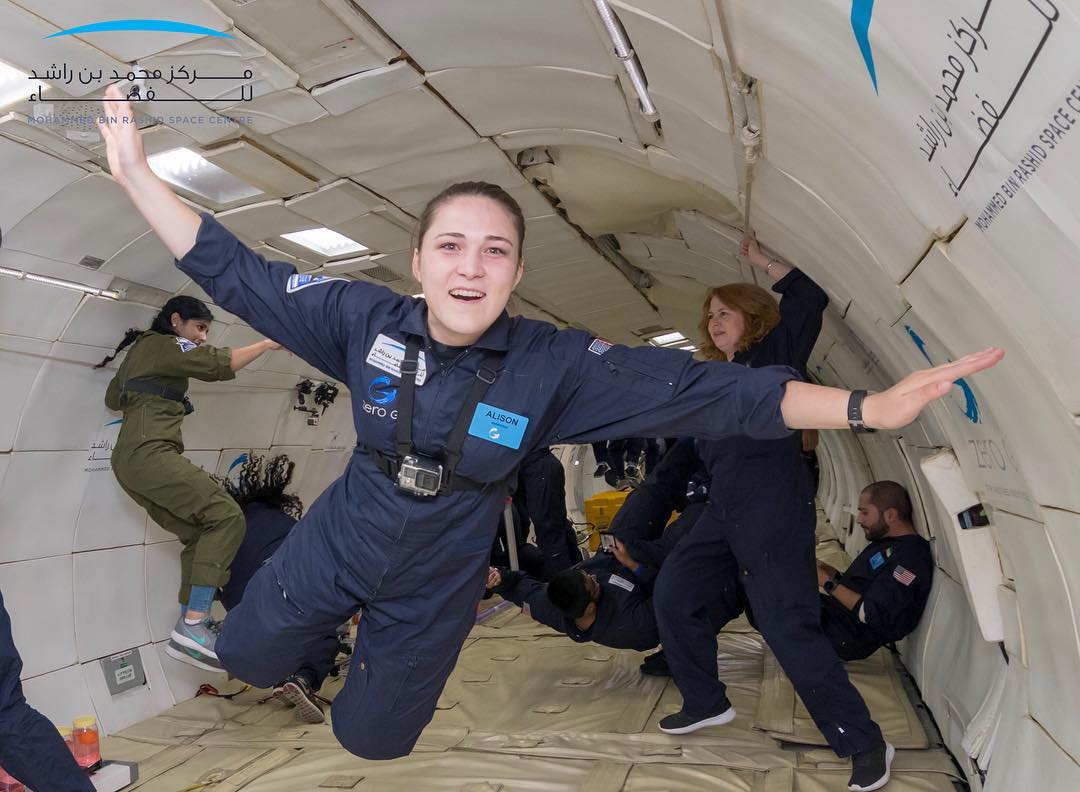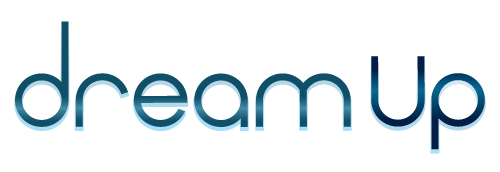
I’m Alison Waterman, the newest member of the DreamUp team! Now that I’ve been with DreamUp for six months, I’ll share a bit about my journey to a career in the space industry and what I’ve been working on so far.
In the second year of my undergraduate program in Electrical Engineering at New York University Abu Dhabi, I found out about an interesting opportunity. Dubai’s Mohammed bin Rashid Space Centre announced a competition for UAE students to propose experiments that could be performed in microgravity. The top 15 competition winners would get to implement their experiment in actual microgravity on a special experience called a parabolic flight.
In case you haven’t heard of a parabolic flight, sometimes called the “vomit comet” for its tendency to produce motion sickness, I’ll explain a little bit about what it is. You know the moment of weightlessness you get at the top of a roller coaster hill before plummeting down again? The parabolic flight works using a similar idea, but with enormous “hills” that are made by an airplane flying up and down in a special parabolic shape. This maneuver produces repeated intervals of about 25 seconds of microgravity, followed by 25 seconds of 1.8g, or nearly twice Earth’s gravity. These flights are used to train astronauts, but they’ve also become a tool for scientific research, filming movies and music videos, and even for ordinary tourists.

Although I knew very little about space research at the time, the idea of floating in microgravity sounded too incredible to miss. I called one of my classmates, spent some time reviewing publications on microgravity research, and came up with the idea to test muscle movements in microgravity using electrical sensors placed on the surface of the skin.
After an interview and plenty of emails back and forth to ensure that our experiment met the safety requirements for the flight, I was selected as one of the finalists. My team traveled to Florida where the experiment would take place.
The feeling of microgravity was unlike anything in the world. As soon as the plane’s position changed at the start of each interval, I immediately floated off the floor in whatever position I was in. As if I was swimming, I tried to kick my legs and move my arms to get around, but there was nothing to stop me from drifting through the air! The tiniest push off the ground would send me flying to the top of the aircraft, which was thankfully covered in padding. While my research partner did the muscle movements, I used the foot straps to anchor myself to the floor and recorded the sensor data using a laptop that was secured in place with velcro. As we tried to position ourselves and ended up flying in all directions, everyone on the flight was smiling, laughing, and cheering.

The lessons I learned from the competition and the mentorship I received during this experience stuck with me long after I returned to the UAE. As an aspiring engineer, I thought about how the space environment produces problems with interesting constraints. Space technologies often have to survive extreme conditions using limited materials, and once equipment is launched to space, it can be difficult to test and troubleshoot. Space technology pushes the boundaries of what is possible and requires a high level of technical skill. I realized that working in the aerospace field would allow me to solve interesting problems that could also impact life on Earth.
The next semester, a professor approached me and asked if I would help organize an aerospace club for students at NYU Abu Dhabi. I quickly agreed! As the president of the Aerospace Club at NYU Abu Dhabi, I led several student competition projects and organized events to support student interest in space science and technology.
As I approached my graduation in the Spring of 2020, I wasn’t entirely sure what direction my life would take. I loved space technology and had gained a foundation in electrical engineering, but I was also interested in other fields like international development and education. As the COVID-19 pandemic led to the cancellation of the Aerospace Club’s in-person events, I realized that one of the things I would miss most was leading these projects and teams. I thought back to my experience two years before, when a student competition had sparked my initial interest in space research.
When I found DreamUp through its initiatives in the UAE, things started to make sense. Was it really possible to have a job that combined space technology, student competitions, international collaboration, and STEM education? It turns out that it absolutely was.
I started as an intern and eventually joined DreamUp full-time in September 2020. I’ve been working remotely since I started, but that hasn’t stopped me from meeting an amazing and dedicated team. Since I began working at DreamUp, I’ve been able to help give students what was once given to me: opportunities to participate in space research through competitions and educational programs.
Here are a few of the exciting initiatives I’ve been able to work on in the past four months at DreamUp:
One of my first tasks was to help edit the DreamCoder curriculum materials. The DreamCoder program allows students to write their own code and send it to hardware on the International Space Station. Students learn the fundamentals of engineering design and the scientific method as they investigate a topic from start to finish.
The Space Farmer DreamKit is DreamUp’s newest STEM experiment kit. It contains all the materials for students to grow their own plants on Earth and compare them to plants in space!
Marketing was something new for me, but I spent some time developing Amazon advertisements and social media posts to promote the kit. It was interesting to learn how to bring a product to life and manage an e-commerce sales pipeline.
This competition in collaboration with NASA’s STEM on Station allows students at U.S. colleges and universities to design and build an experiment to fly to and return from the International Space Station. DreamUp is supporting program management and logistics for this competition in collaboration with our sister company Nanoracks. The five selected finalist teams are developing their microgravity experiments to send to the International Space Station with the help of Nanoracks mission managers.
The STARward STEM program is working with RTI and Cumberland County Schools in North Carolina to send student projects to the International Space Station as a payload aboard a scheduled rocket launch. Over the next three years, DreamUp will support teacher training, curriculum development, and other programmatic aspects of the experiment development and launch. Planning this program has been a highlight of my experience at DreamUp.
My first six months working full-time at DreamUp have been full of lots of new experiences and personal growth. I’m excited for what the future holds and can’t wait to see these initiatives unfold and shape the future of STEM and specifically aerospace education. I look forward to seeing where my space journey takes me at DreamUp — onward and upward!
For more information about how DreamUp enables student research in space, contact us at info@dreamup.org.
By Alison Waterman, Project Specialist at DreamUp
